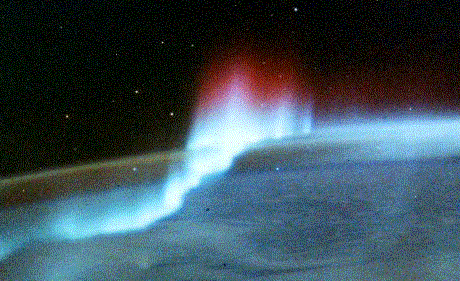
 |
The space between the planets is far from empty. It contains: electromagnetic radiation (photons); hot plasma (electronsĦA protons and other ions) a.k.a. the solar wind; cosmic rays; microscopic dust particles; and magnetic fields (primarily the Sun's).
While the Sun's radiation is obviousĦA the other components of the interplanetary medium were not discovered until very recently.
The temperature of the interplanetary medium is about 100ĦA000 K. Its density is about 5 particles/cm3 near the Earth and decreases by an inverse square law farther from the Sun. HoweverĦA the density is highly variableĦA it can be as much as 100 particles/cm3.
Though very tenuousĦA it has measurable effects on the paths of spacecraft.
Except near some of the planetsĦA interplanetary space is filled with the Sun's magnetic field. Its interactions with the solar wind are very complicated. Within a few solar radii of the Sun the magnetic field determines the flow of the solar wind; much of the flow is trapped in magnetic loops. But some regions of the Sun's magnetic field are open allowing the solar wind to escape. Farther out the plasma dominates and the magnetic field is entrained in the particle flow.
Some planets (e.g. EarthĦA Jupiter) have their own magnetic fields. These create smaller magnetospheres that dominate the Sun's influence within their boundaries. Jupiter's magnetosphere is very largeĦA extending over a million km in all directions and as far as the orbit of Saturn in the direction away from the Sun. The Earth's much smallerĦA extending only a few thousand kmĦA but protects us from the otherwise very dangerous effects of the solar wind.
For non-magnetic bodiesĦA such as the MoonĦA the solar wind impacts the surface directly.
As the solar wind moves out into spaceĦA it creates a magnetized bubble of hot plasma around the SunĦA called the heliosphere. EventuallyĦA the expanding solar wind encounters the charged particles and magnetic field in the interstellar gas. The boundary created between the solar wind and interstellar gas is the heliopause. The precise shape and location of the heliopause is not known but it is probably similar in shape to the Earth's magnetosphere and the bow shock is probably about 110 - 160 AU from the Sun. The Voyager and Pioneer spacecraft will probably reach the heliopause in another decade or so.
The Ulysses spacecraft is conducting an extensive study of the Sun and the solar wind.
The highest energy particles in the interplanetary medium are called cosmic rays. Some are of solar origin; the most energeticĦA howeverĦA originate in some other unknown and very energetic processes outside our solar system.
 The interaction of the solar windĦA the Earth's magnetic field
and the Earth's upper atmosphere causes the
auroras.
Other planets with significant magnetic fields (esp. Jupiter) have similar effects.
The interaction of the solar windĦA the Earth's magnetic field
and the Earth's upper atmosphere causes the
auroras.
Other planets with significant magnetic fields (esp. Jupiter) have similar effects.
The zodiacal light and the gegenschein are caused by interplanetary dust.
